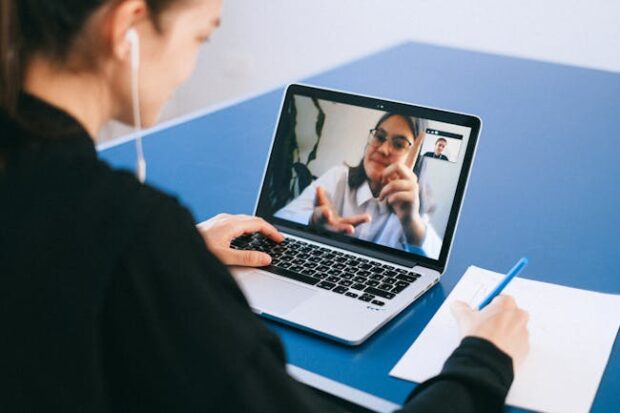How to reduce fatigue from online meetings
Have you ever felt exhausted after online meetings?
You’re not alone as more people experience fatigue from video conferencing.
Experts call it “videoconferencing fatigue (VF)” or “Zoom fatigue,” which is the tiredness you feel after an online session.
Fortunately, you can make online work less stressful with a few adjustments.
READ: Zoom fatigue can harm your mind and heart
This article will explain how to reduce online meeting fatigue, from changing your background to moving farther from your webcam.
1. Use smaller windows for online meetings

Stanford communication professor Jeremy Bailenson shared tips on handling videoconferencing fatigue in the Stanford Report.
He explained we get tired of online meetings because it is highly different from conventional ones.
Normal meetings require you to look at the speaker, and you may glance elsewhere or take notes.
On the other hand, Zoom calls require everyone to look at other on-screen participants at all times.
Meanwhile, everyone else seems to be looking at you from the screen.
As a result, you feel like you’re also speaking to the crowd, raising your social anxiety.
“When you’re standing up there, and everybody’s staring at you, that’s a stressful experience,” Bailenson said.
Another source of stress is the monitor size.
If yours is too wide, it simulates the personal space you experience when you’re face-to-face with someone.
Our brains link that experience to mating or to conflict, which triggers a hyper-aroused state.
As a result, the screen size is another cause of online meeting fatigue.
Professor Bailenson recommends reducing the Zoom window size and using an external keyboard to extend our distance from the screen.
2. Hide your self-view

Online meetings typically involve seeing ourselves on screen, which is unnatural in a real-world setting. Imagine speaking to your friend while they had a mirror beside them!
Bailenson stated that many studies suggest that seeing your self-reflection encourages you to be more self-critical.
Seeing yourself while talking is like requiring our brains to focus on ourselves and the person in front of us simultaneously.
READ: How to hide mobile apps
The professor recommends using the “hide self-view” button:
- Put your mouse pointer or cursor over your self video screen.
- Next, click the three-dot button to display the menu.
- Click the Hide Self View button.
If your class or company requires you to show your self-view window, request short breaks during meetings.
Next, remain on camera and then close your eyes during the break.
3. Distance yourself from your screen

You can usually walk around while speaking to someone face-to-face or via phone.
Conversely, you must sit still for hours during online meetings, limiting your movement unnaturally.
“There’s a growing research now that says when people are moving, they’re performing better cognitively,” Bailenson explained.
The Stanford educator suggests putting your external camera farther from the screen so that you can pace around during online meetings.
If your computer has a built-in webcam, you may try walking around while remaining in view.
Ideally, request a few minutes away from the screen for a brief non-verbal and visual break.
4. Give yourself an “audio only” break

Professor Jeremy Bailenson says online meetings can make face-to-face interaction more stressful.
It requires us to be more conscious about our actions and reactions to facilitate communication.
“You’ve got to make sure that your head is framed within the center of the video,” the communications professor said.
In contrast, we instinctively look at people’s faces when they’re talking.
“If you want to show someone you’re agreeing with them, you do an exaggerated nod or put your thumbs up,” Bailenson added.
Conversely, you can show approval with a simple smile or grunt when you’re face-to-face with someone.
Gestures can also have different meanings in video meetings.
For example, glancing to the side while speaking to someone in person could mean they noticed something moving nearby.
On the other hand, you’re not sure what’s around a speaker during online meetings.
As a result, their sidelong glance may seem disrespectful, even though they just saw their child running off.
READ: How to host a Zoom meeting
The communications professor recommends taking “audio only” breaks. These actions involve turning off your camera and walking away from the screen.
As a result, you have “a few minutes you are not smothered with gestures that are perceptually realistic but socially meaningless.”
5. Use a static background

Nanyang Technological University Wee Kim Wee School of Communication and Information researcher Heng Zhang and his team studied the impact of Zoom backgrounds on videoconferencing fatigue.
They surveyed over 600 people aged between 22 to 76 regarding their use of virtual backgrounds.
As a result, those who used video backgrounds reported the highest fatigue levels after online meetings.
Blurred background users usually had more fatigue than those using static images.
Moreover, stationary background images caused the least amount of fatigue.
“Image backgrounds initially present new information, but users might gradually shift their attention elsewhere,” explained Zhang on Frontiers in Psychology.
The researchers also learned that static images depicting nature or lighthearted and funny themes caused the least videoconferencing fatigue.
Hence, you should consider using wholesome or nature-themed static background images for online meetings.